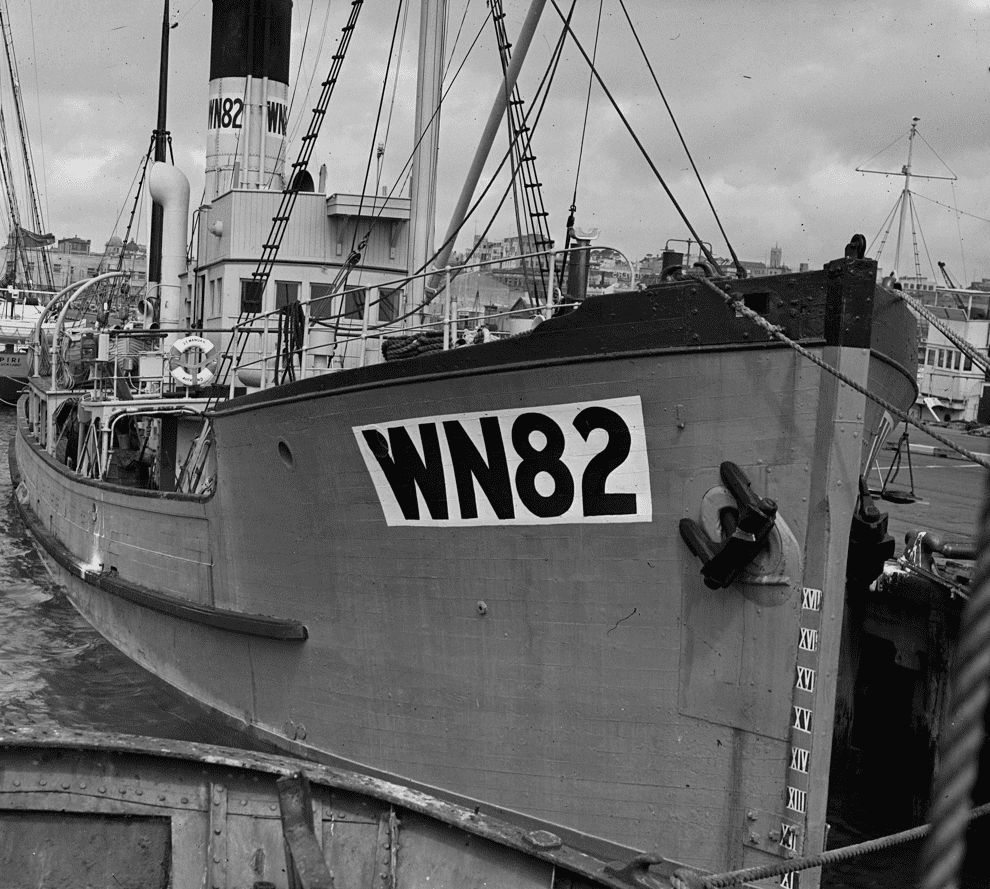Build Date
1941
Boat Builder
Mason Bros. Engineering Co. Ltd. (W.G. Lowe & Sons Ltd.)
Length
135.9 Feet
Beam
23.3 Feet
Manuka’s War Work
Built in 1941 for the Royal New Zealand Navy as a ‘double L’ magnetic minesweeper. There were only three built for the NZ Navy and all were named after NZ trees. The other two were Rimu and Hinau. The speed at which these boats has to be built meant they built with steel frames and wooden planking to speed up the process. They also had limited resources available, so the boilers, steering and steam engines were salvaged from “rotten row” and reconditioned by Devonport Dockyard in Auckland. The Manuka’s main engine and boiler came from the SS Rangitoto a veteran of World War 1 which was laid up in 1937.
However, the salvage materials meant the boats had to be altered to take these unique items and even after the funnels were made bigger and extra ventilation was added the boats were still uncomfortably hot in the engine room for those working in there.
The manuka was based in Auckland during the war but also worked out of Wellington amongst other NZ ports. But at the end of the war her war equipment was removed, and she was put in the reserves in Auckland.


Manuka’s Fishing Career
In September 1946 Manuka took on a new career as she started a 5 year lease to the Chatham Fishing Co Ltd. This was a syndicate formed to fish for blue cod in the Chatham Islands. Each shareholder paid 200 pounds to join and they mostly comprised of merchant navy officers and crew returned home after WWII. Chartering Manuka cost the syndicate 500 pounds per year and helped re-establish a link between Wellington and the Chatham Islands which had been removed during the war.
Before the syndicate could start fishing Manuka needed altering. This included adding refrigeration and reworking the crew accommodations as Manuka no longer needed accommodation for 27 crew members. Instead, Manuka would work with 12 crew all of whom were shareholders except the cook.
Manuka’s first Master was John Flett, the Chief Engineer was Fred Abernethy of Tyneside England, the Second Engineer was Jim Winton from Glasgow, Scotland. Nets, Lines and Pots tells several stories of Fred Abernethy’s fondness for shark fishing off the Manuka when they were finished working for the day. He is said to have almost caught Topunga Charlie a 30 feet long shark as well as pulling a 12-foot shark on deck at Pitt Island only for it to have been almost bitten in half by a much bigger shark jumping out of the water and stealing his catch.
Manuka In The Chatham Islands
Although Manuka was registered as a fishing vessel she primarily worked as mother ship for other smaller fishing boats that would catch the fish around the Chatham Islands. The skippers of these smaller boats included Ted and Philip Neilson, Charlie Hill, Bunty and Charlie Preece, Alf Wisener and the Donaldson brothers of Owenga. Manuka would follow these skippers and their fleet around the Chatham Island’s receiving their catch in the evening and weighing it. They then employed Chatham Islanders to clean and process the fish into boxes which were then stored in Manukas cooler. At night the fleet tied up alongside Manuka and the crews would have dinner together on the Manuka. Once they had filled up the Manuka’s hold, she would travel back to Wellington along with any mail and machinery that needed parts. They then sold their catch to the Wellington Trawling Company and after a few days in port loading up on supplies for the islanders they would return to the Chatham Islands.
During her fishing years Manuka’s engines were still hard work with an insatiable and expensive taste for coal. As well as a constant need for attention to keep them going. They also hit their share of bad weather including their first trip to the Chatham Islands which would have ended in disaster with a less skilled skipper.
Around 1950 the syndicate sold their shares to the Wellington Trawling Company who used her as a floating freezer for the local cod fishing boats at Port Hutt on the Chatham Islands. Only two years later on 4 October 1952 Manuka was found sunk on her mooring and although she was still in one piece she was not salvaged. It is thought an incident three months earlier when Manuka dragged her mooring may have caused a slow leek.
In the late 1990s Manuka was still lying in around 35ft of water, intact but with her funnel and mast collapsed.

References
To research Manuka we use the book Nets, Lines and Pots: a History of New Zealand Fishing Vessels Vol 2.
Related Posts
Marilyn – 112 ft NZ Navy vessel built in 1943 and deployed during WWII.
Taupata – Niccol Trading vessel Requestioned by US Navy in WW2.
Hautapu – NZ Navy minesweeper built during WWII. Worked on the Canterbury Project and later owned by NZ Fisheries.
Tio – 55 ft. research boat, Navy Pilot boat, passenger vessel, skipper training boat, lighthouse tender and private launch.
